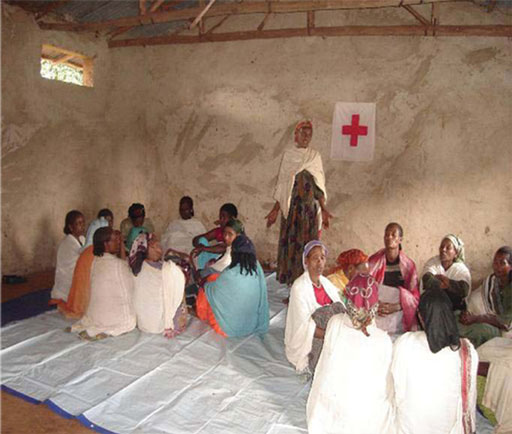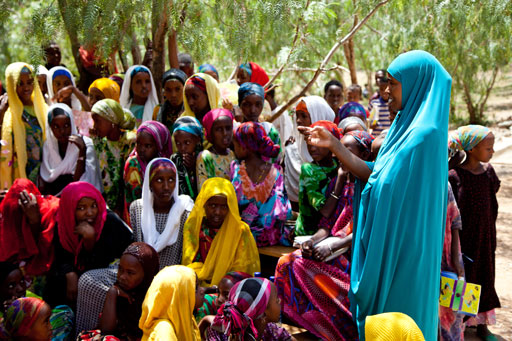9.3 Behaviour change communication
In the context of WASH initiatives, behaviour change communication is communication that is intended to help individuals change their behaviour so that they develop more healthy practices. It attempts to bridge the gap between factual information, a person's knowledge and attitudes, and their subsequent behaviour.
This approach addresses the knowledge, attitudes, practices and skills of individuals as they relate to specific WASH programme goals. Targeted individuals gain more accurate knowledge, and hence change or develop attitudes and skills that will motivate them to develop more positive, healthy and protective practices. Now read Case Study 9.2 and answer the questions that follow.
Case Study 9.2 Child marriage and its reduction
In a rural woreda, there had been frequent occurrences of child marriage. This continued for many reasons, but the central issues were that the local authorities did not consider child marriage a problem and there were no punitive measures towards the perpetrators.
In an effort to reverse these trends, a behaviour change strategy was developed to convince local level decision makers to take action. They were encouraged to establish ‘action committees’ and force parents to get permission from the kebeleadministration before they could arrange a wedding for their daughters. The kebeleadministration issues permission for the marriage only after making sure, through testimonies of witnesses,that the bride is at least 18 years of age. The establishment of the ‘action committees’ have resulted in girls having somewhere to go for support and advice when their rights are violated. In addition, community conversations (Figure 9.4) were conducted in the communities to empower them to draw up bylaws to stop the child marriage practice. Religious leaders, women’s associations and youth groups were brought on board to create awareness of the issues involved.

Because of all these interventions, there has been a noticeable reduction in incidences of child marriage. Young girls in the woreda are now less likely to drop out of school to marry, as no man can marry a woman without written approval of the kebele administration. In addition, counselling sessions have been introduced in the primary school, and students are encouraged to discuss child marriage and girls' education as part of Girls' Forum and Girls' Club activities. Such a session is shown in Figure 9.5.

The two main reasons why child marriage continued to be practised were that the local authorities did not consider it to be a problem and it was not punished. Which of the subgroups of behavioural determinants in the FOAM framework are demonstrated by these reasons?
The first indicates that the local authorities were not motivated to change because of their attitudes to child marriage and their values. Child marriage was also a social norm in this community. The lack of punishment shows how sanctions and enforcement can influence behaviour.
Identify two individual behaviour changes that helped to reduce child marriage in this case study.
The answer is as follows:
- Parents were helped to understand the negative effects of child marriage.
- Parents were encouraged to seek permission of the kebele administration before arranging marriages.
Behaviour change communication is concerned with influencing the behaviour of individuals. Individuals are highly influenced by factors in the environment around them, such as gender, power and culture, as well as by the organisation of their local community and the political and economic environment. This is explained in Section 9.4.
9.2 Channels for communication
